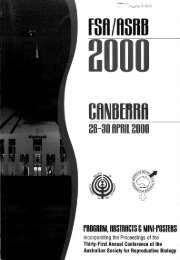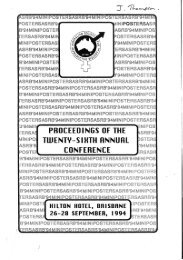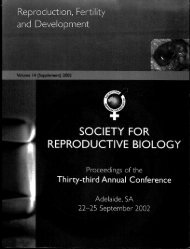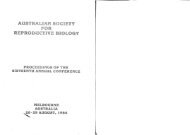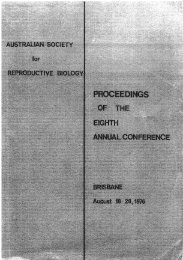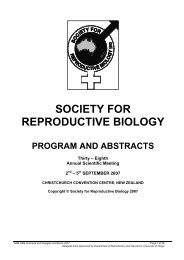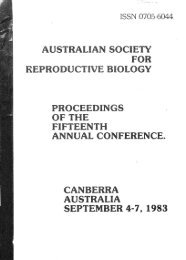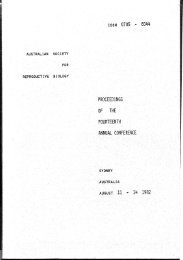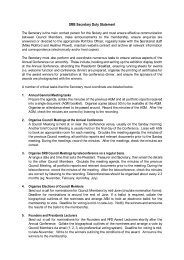N OCIETY' - the Society for Reproductive Biology
N OCIETY' - the Society for Reproductive Biology
N OCIETY' - the Society for Reproductive Biology
Create successful ePaper yourself
Turn your PDF publications into a flip-book with our unique Google optimized e-Paper software.
Birth of lambs following vitrification of in vitro produced ovine embryosG Evans, KM Rao, NM Fogarty* & WMC MaxwellDepartment of Animal Science, The University of Sydney, NSW 2006 &*NSW Agriculture, Agricultural Institute, Orange, NSW 2800IntroductionVitrification is potentially a cheap and simplemethod of cryopreservation of embryos. Thetechnique has been applied to ovine embryosproduced in vivo but not extensively to thoseproduced in vitro. This experiment was designedto compare pregnancy rates and development toterm of in vitro and in vivo produced vitrifiedembryos. For comparison, conventionally frozenembryos were contemporaneously transferred tosurrogate ewes and a fur<strong>the</strong>r group of ewes wasinseminated with frozen semen (Fogarty et al;1999).Materials & MethodsOocytes were sourced from adult Merino ewes at alocal abattoir, and matured and fertilised in vitro(O'Brien et aI, 1996). Presumptive IVP zygoteswere cultured in SOF-BSA <strong>for</strong> up to 8 days.Blastocysts were removed from culture on days 6, 7and 8, and any remaining late morula stageembryos were also removed on day 8. All embryoswere immediately vitrified in 0.25 ml straws inVS3a according to <strong>the</strong> method of Rall & Wood(1994). Embryos were also vitrified aftercollection from superovulated Merino ewes on day6 (day 0 = oestrus). All such embryos were devitrifiedand transferred in pairs to <strong>the</strong> uteri of 91synchronised BLxMerino ewes on day 6. Plasmasamples were taken on day 18-19 and assayed <strong>for</strong>progesterone; ewes with plasma concentrations >1nglml were judged pregnant. Ultrasonic pregnancydiagnosis was also per<strong>for</strong>med on day 54-55, and <strong>the</strong>day of lambing and number of lambs born werealso recorded. For comparison, <strong>the</strong> per<strong>for</strong>mance ofewes carrying long-term' conventionally frozen'embryos (n=207) and ewes inseminated with frozensemen on day 0 (n=51) was assessedcontemporaneously (Fogarty et al; 1999). Datawere analysed by X 2 and maximum likelihoodprocedures.ResultsThe results of pregnancy diagnosis at days 18-19and 54-55 are presented in Table 1Table 1. Pregnancy rates of ewes with vitrifiedembryos (n=2 embryos per ewe)Group n % % numberewes Pregnant Pregnant fetusesd18 d54-55IVPd6 27 74.1 44.4 16IVPd7 20 68.4 50.0 11IVPd8 20 50.0 25.0 7in vivo 24 50.0 33.3 10There were no significant differences in pregnancyrates between vitrification treatment groups atei<strong>the</strong>r stage of pregnancy. However, at d18-19 <strong>the</strong>pregnancy rates <strong>for</strong> NP embryos at d6 and d7 weregreater than <strong>for</strong> frozen embryos (49.5%; P



